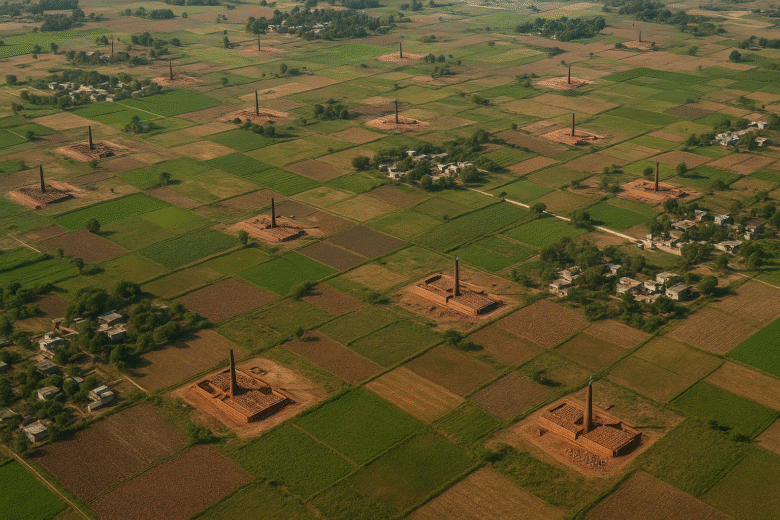Fun Fact: Did you know that over 47,000 brick kilns across the Indo-Gangetic plain in India have been detected using satellite imagery and machine-learning?
In this age of soaring skyscrapers and sleek smartphones, it’s ironic that a humble brick still plays a starring role in India’s construction boom — and stays largely hidden from view. The title of this article, “Brick Kilns Under Satellite Watch: Space Tech Meets Environmental Law,” speaks to a seismic shift: what was once a forgotten corner of industry is now under the gaze of satellites, artificial intelligence (AI) and law-enforcement. And that’s exactly where we should be looking.
Why Brick Kilns Still Matter
We often blame big factories or vehicles for our air-quality woes. But the brick-making sector is quietly massive. In India alone, traditional kilns contribute between 8 % and 14 % of air pollution in the densely-populated Indo-Gangetic plain. The typical kilns burn coal or biomass, emit toxic particulates, and stand close to human habitations. Some use top-soil that could have been farmland.
And yet, regulation has lagged. These kilns often fall outside formal oversight, shrouded in the haze they create.
The Game Changer: Satellites, AI and Compliance
Enter the “Eye in the Sky” era. Through satellite imagery combined with AI models like YOLO (you only look once), researchers are mapping and identifying kilns across thousands of square kilometres. In one study, nearly 19,579 new kilns were found across nine states in India, and many were violating rules about how close they could be to villages, rivers or hospitals.
Another initiative by United Nations Development Programme (UNDP) India and the University of Nottingham used machine-vision to create a GeoAI platform that flagged 1,655 high-risk kilns in the state of Bihar for inspection.
What this means in plain terms: regulators no longer have to walk countless dusty lanes hoping to find a rogue kiln. They can zoom in, scan thousands of locations, and send enforcement teams where they are needed most.
Case Study: Bihar Gets a Bird’s-Eye View
In Bihar, the GeoAI platform detected kilns, analysed their conditions and matched them with labour and emission violations. The result? About 1,000 kilns were green-converted (i.e., upgraded) and half a million tonnes of CO₂ per annum were avoided. That’s not just a tech victory; it’s a victory for people breathing the air.

Challenges Still Ahead
Technology is only part of the solution. The law still needs teeth, and the on-ground enforcement still needs legs. Some kilns detected from space may still operate under the radar. Retrofitting older kilns into cleaner types (like Zigzag kilns) costs money and involves labour-cash issues.
Furthermore, the people behind these kilns—often workers and small owners—need support. A satellite can spot a kiln illegally close to a river, but it can’t negotiate jobs or alternate livelihoods. Without just transitions, enforcement risks punishing the vulnerable instead of the perpetrators.
Why This Matters to You and Me
Because when those chimneys smoke, we smell the consequences: polluted air, health risks, and even lost fertility of land from top-soil removal. If the atmosphere over Delhi or Kolkata thickens after a big ash plume from a cluster of kilns, the cost may end up in your hospital bill or your child’s dusty playground. The fact that satellites can now detect the source means we have a chance to hold someone accountable.
Moreover, from a policy standpoint, this model of remote-monitoring could extend to many sectors: e-waste sites, mining, deforestation. If we’re serious about sustainability, we must stop thinking that unseen is unpoliced.
Conclusion: From Smoke to Surveillance, From Neglect to Notice
Brick kilns have long constructed our homes and cities. Yet now they expose how hidden industries can evade oversight and pollute unchecked. But “Brick Kilns Under Satellite Watch: Space Tech Meets Environmental Law” shows there’s hope. Space-based monitoring, AI analytics and environmental law are converging to bring kilns into the light.
Still, light alone isn’t enough. We must back it with action: policy enforcement that is fair, transitions for workers, and civic vigilance. If you breathe the air, stare out your window at the skyline or wonder where the bricks in your flat came from—you have a stake. It’s time we looked up at the sky, not just to admire satellites, but to demand accountability.
Let’s face this: the bricks of the future should not be built on the backs of the atmosphere or the margin of legality. So ask your representative: are our kilns still burning out of sight? Because now we can see them.
Author’s Note
Late one night, I found myself staring at a satellite-image that flagged hundreds of tiny kiln-clusters across the plains. They looked like charcoal dots on the landscape—silent, remote, yet unmistakably present. Writing this blog wasn’t just about data or policy—it was about recognising that technology can shine a light on what we’ve ignored. And when we write, we’re not just informing—we’re inviting you into that light, to look, ask, challenge. Because if we don’t watch them, they’ll keep watching us.
G.C., Ecosociosphere contributor.
References and Further Reading
- Brick Kiln Monitoring in India — UNDP Accelerator Lab case study
- Eye in the Sky: Detection and Compliance Monitoring of Brick Kilns using Satellite Imagery
- GeoAI Platform is Helping Target Brick Kiln Hotspots of Air-Pollution
- Towards Scalable Identification of Brick Kilns from Satellite Imagery with Active Learning
- Detecting and Categorizing Brick Kilns from Satellite Imagery — ArcGIS Sample
- Assessing and Monitoring Spatial Distribution of Brick Kilns in a Part of North India using Remote-Sensing & GIS




